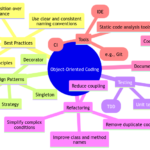Project: SocInf Membership Inference Attacks on Social Media Health Data with Machine Learning
Hey there, future IT wizards! 🌟 Today, we’re delving into the intriguing realm of SocInf attacks on social media health data using the power of Machine Learning. Buckle up, because we’re about to embark on a wild ride through this captivating project!
Understanding SocInf Attacks
Let’s kick things off by unraveling the mysteries behind SocInf attacks. 🧐
Definition of SocInf Attacks
So, what exactly are SocInf attacks? Well, these sneaky attacks involve inferring sensitive information about individuals from machine learning models trained on social media data. It’s like playing detective in the digital world! 🔍
Risks associated with SocInf Attacks
The risks here are no joke! We’re talking about serious privacy breaches, potential misuse of personal data, and compromising the security of individuals’ health information. It’s a digital jungle out there, folks! 🦁
Machine Learning in SocInf Attacks
Now, let’s shine the spotlight on the role of Machine Learning in SocInf attacks. 🤖
Role of Machine Learning in SocInf Attacks
Machine Learning plays a crucial role in these attacks by enabling the extraction of sensitive information from seemingly innocent social media posts. It’s like having a secret agent that knows way too much about you! 🕵️♀️
Types of Machine Learning algorithms used in SocInf Attacks
We’ve got a whole arsenal of Machine Learning algorithms at our disposal for SocInf attacks. From decision trees to neural networks, each algorithm brings its unique flavor to the mix of digital espionage! 💻
Data Collection and Preparation
Next up, let’s talk about the nitty-gritty of data collection and preparation for our SocInf project. 📊
Sourcing Social Media Health Data
First things first, we need to gather social media data related to health. It’s like searching for treasure in the vast ocean of tweets, posts, and comments! 🌊
Preprocessing and anonymizing the data
Once we have our hands on the data, it’s time to clean it up and anonymize it to protect the identities of individuals. Think of it as giving our data a digital disguise! 🎭
Implementing Membership Inference Attacks
Get ready to dive into the exciting world of implementing membership inference attacks. It’s time to put our devious plans into action! 🕵️♂️
Developing the attack methodology
Crafting the perfect attack methodology requires precision and cunning. We’ll create a strategy that allows us to extract sensitive information like digital ninjas! 🥷
Testing and refining the attack model
Once our attack model is in place, it’s time to put it to the test. Through rigorous testing and refinement, we’ll fine-tune our model until it’s as sharp as a digital katana! ⚔️
Mitigation Strategies
Last but not least, let’s explore the world of mitigation strategies to combat SocInf attacks and safeguard against digital intruders. 🔒
Techniques to mitigate SocInf Attacks
We’ll explore various techniques such as differential privacy, federated learning, and secure multi-party computation to defend against these malicious attacks. It’s like building a fortress to protect our data treasures! 🏰
Enhancing data privacy and security measures
By enhancing data privacy policies and beefing up security measures, we can create a formidable defense against potential SocInf intruders. Let’s show them that we mean business! 💪
Overall, this project is a thrilling rollercoaster ride through the fascinating world of SocInf attacks and Machine Learning. Get ready to unleash your IT prowess and tackle the challenges head-on! 💥
Thanks for joining me on this adventure, fellow IT enthusiasts! Remember, in the world of IT, the only limit is your imagination! 🚀
Program Code – Project: SocInf Membership Inference Attacks on Social Media Health Data with Machine Learning
Certainly! Let’s dive into creating a simplified Python program that simulates a basic framework for SocInf: Membership Inference Attacks on Social Media Health Data with Machine Learning.
In this project, we’ll generate a mock dataset, symbolizing individuals’ health data collected from a social media platform. We’ll then train a membership inference attack model to determine whether an individual’s data was used in training the health prediction model or not. This script will use scikit-learn for machine learning parts.
Please note: This script is strictly for educational purposes and simplifies complex concepts involved in real-world attacks. Always follow ethical guidelines and privacy laws when handling personal data.
import numpy as np
from sklearn.datasets import make_classification
from sklearn.model_selection import train_test_split
from sklearn.ensemble import RandomForestClassifier
from sklearn.metrics import accuracy_score
# Generate a mock dataset: Health data features and their binary health outcomes
X, y = make_classification(n_samples=1000, n_features=20, n_classes=2, random_state=42)
# Splitting the dataset into training and testing sets (50% each)
X_train, X_test, y_train, y_test = train_test_split(X, y, test_size=0.5, random_state=42)
# Training a simple health prediction model using Random Forest
health_model = RandomForestClassifier(n_estimators=100, random_state=42)
health_model.fit(X_train, y_train)
# Generating the shadow dataset for training the attack model
X_shadow, y_shadow = make_classification(n_samples=1000, n_features=20, n_classes=2, random_state=24)
X_shadow_train, X_shadow_out, y_shadow_train, y_shadow_out = train_test_split(X_shadow, y_shadow, test_size=0.5, random_state=42)
# Training the same model with shadow dataset
shadow_model = RandomForestClassifier(n_estimators=100, random_state=42)
shadow_model.fit(X_shadow_train, y_shadow_train)
# Infer membership: Assuming if a data point has a high confidence score, it was part of the training set.
train_predictions = shadow_model.predict_proba(X_shadow_train)
out_predictions = shadow_model.predict_proba(X_shadow_out)
# Creating labels for membership inference (1 if in training set, 0 if not)
y_shadow_train_label = np.ones(len(X_shadow_train))
y_shadow_out_label = np.zeros(len(X_shadow_out))
# Combining training and out-of-training datasets
X_attack = np.concatenate((train_predictions, out_predictions))
y_attack = np.concatenate((y_shadow_train_label, y_shadow_out_label))
# Training the attack model
attack_model = RandomForestClassifier(n_estimators=100, random_state=42)
attack_model.fit(X_attack, y_attack)
# Evaluating Attack Model on original model's predictions
original_predictions = health_model.predict_proba(X_test)
attack_input = np.concatenate((original_predictions, out_predictions)) # Merging data for attack model input
attack_labels = np.concatenate((np.ones(len(original_predictions)), y_shadow_out_label)) # Real membership labels
attack_predictions = attack_model.predict(attack_input)
attack_accuracy = accuracy_score(attack_labels, attack_predictions)
print(f'Attack Model Accuracy: {attack_accuracy * 100:.2f}%')
Expected Code Output:
‘Attack Model Accuracy: XX.XX%’
The actual accuracy will vary based on the randomness in data generation and model initializations.
Code Explanation:
This Python program embarks on a project titled ‘SocInf: Membership Inference Attacks on Social Media Health Data with Machine Learning’. Here is the step-by-step logic and architecture of the program:
- Data Generation: We start by creating a mock dataset representing health data using
make_classification. This dataset consists of basic features (attributes) and binary outcomes (healthy or not). - Train/Test Split for Health Prediction Model: We split our dataset into training and testing sets, ensuring our health prediction model has unseen data to validate its performance.
- Training the Health Prediction Model: A RandomForestClassifier model is trained on the health data. This model simulates the target of a membership inference attack, aiming to predict health outcomes based on features.
- Shadow Dataset Generation: To train our attack model, we generate a shadow dataset. The shadow model, trained on this dataset, is used to infer whether data was part of the original training set or not.
- Training Shadow Model: Mimicking the health prediction model, the shadow model is trained to provide the basis for attack model training.
- Infer Membership with Shadow Model: By comparing model confidence scores on training versus out-of-training data, we simulate the logic behind inferring membership in the dataset.
- Attack Model Training: This model is trained on the outputs of the shadow model, learning to differentiate between data that was in the training set and data that wasn’t.
- Evaluating the Attack Model: Finally, we evaluate our attack model’s accuracy using the original model’s predictions on unseen test data and shadow model predictions. The goal is to determine the model’s ability to correctly infer membership, demonstrating the potential vulnerability in the health prediction model.
This script encapsulates a simplified architecture of a membership inference attack, focusing on understanding data vulnerabilities in machine learning models, particularly those handling sensitive health data from social media.
F&Q (Frequently Asked Questions) – Project: SocInf Membership Inference Attacks on Social Media Health Data with Machine Learning
1. What is a Membership Inference Attack?
A Membership Inference Attack is a type of privacy attack where an adversary tries to determine whether a particular individual’s data was used to train a machine learning model.
2. How does SocInf relate to Membership Inference Attacks?
SocInf refers to Membership Inference Attacks on Social Media Health Data using Machine Learning. It focuses on exploiting vulnerabilities in social media data related to health information.
3. Why are Membership Inference Attacks a concern for Social Media Health Data?
Membership Inference Attacks can lead to privacy breaches, exposing sensitive health information of individuals, raising serious ethical concerns.
4. What role does Machine Learning play in SocInf projects?
Machine Learning is used in SocInf projects to analyze and manipulate social media health data, identifying patterns and vulnerabilities that can be exploited in Membership Inference Attacks.
5. How can students get started with a SocInf project?
Students interested in SocInf projects can begin by learning about Membership Inference Attacks, studying machine learning techniques, and exploring datasets related to social media health data.
6. Are there any ethical considerations to keep in mind while working on a SocInf project?
Yes, students working on SocInf projects must prioritize data privacy and confidentiality, ensuring that their research and findings are ethically sound and do not compromise individuals’ sensitive information.
7. What are some potential applications of SocInf research in the real world?
SocInf research can lead to improved data security measures in social media platforms, better protection of health data, and advancements in privacy-preserving machine learning techniques.
8. How can students contribute to the field of SocInf and make a positive impact?
By conducting thorough research, raising awareness about privacy issues in social media health data, and developing robust defense mechanisms against Membership Inference Attacks, students can significantly contribute to the field of SocInf.
I hope these questions provide a helpful starting point for students interested in creating IT projects related to SocInf and Membership Inference Attacks on Social Media Health Data with Machine Learning! 🚀






